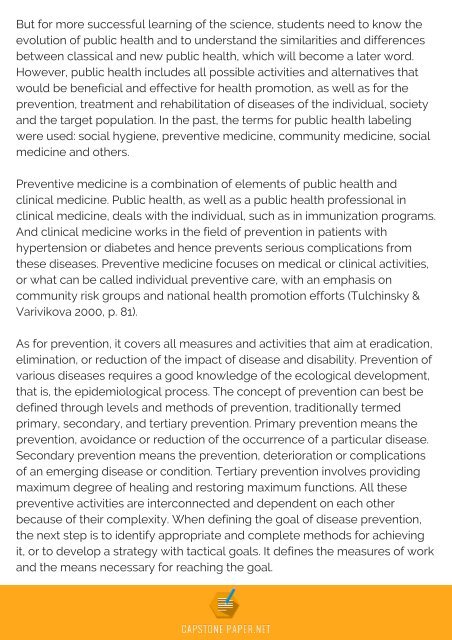Example of DNP Capstone Project
Your attention, please! Just follow this link and check amazing example of DNP capstone project! https://www.capstonepaper.net/
Your attention, please! Just follow this link and check amazing example of DNP capstone project! https://www.capstonepaper.net/
Create successful ePaper yourself
Turn your PDF publications into a flip-book with our unique Google optimized e-Paper software.
But for more successful learning <strong>of</strong> the science, students need to know the<br />
evolution <strong>of</strong> public health and to understand the similarities and differences<br />
between classical and new public health, which will become a later word.<br />
However, public health includes all possible activities and alternatives that<br />
would be beneficial and effective for health promotion, as well as for the<br />
prevention, treatment and rehabilitation <strong>of</strong> diseases <strong>of</strong> the individual, society<br />
and the target population. In the past, the terms for public health labeling<br />
were used: social hygiene, preventive medicine, community medicine, social<br />
medicine and others.<br />
Preventive medicine is a combination <strong>of</strong> elements <strong>of</strong> public health and<br />
clinical medicine. Public health, as well as a public health pr<strong>of</strong>essional in<br />
clinical medicine, deals with the individual, such as in immunization programs.<br />
And clinical medicine works in the field <strong>of</strong> prevention in patients with<br />
hypertension or diabetes and hence prevents serious complications from<br />
these diseases. Preventive medicine focuses on medical or clinical activities,<br />
or what can be called individual preventive care, with an emphasis on<br />
community risk groups and national health promotion efforts (Tulchinsky &<br />
Varivikova 2000, p. 81).<br />
As for prevention, it covers all measures and activities that aim at eradication,<br />
elimination, or reduction <strong>of</strong> the impact <strong>of</strong> disease and disability. Prevention <strong>of</strong><br />
various diseases requires a good knowledge <strong>of</strong> the ecological development,<br />
that is, the epidemiological process. The concept <strong>of</strong> prevention can best be<br />
defined through levels and methods <strong>of</strong> prevention, traditionally termed<br />
primary, secondary, and tertiary prevention. Primary prevention means the<br />
prevention, avoidance or reduction <strong>of</strong> the occurrence <strong>of</strong> a particular disease.<br />
Secondary prevention means the prevention, deterioration or complications<br />
<strong>of</strong> an emerging disease or condition. Tertiary prevention involves providing<br />
maximum degree <strong>of</strong> healing and restoring maximum functions. All these<br />
preventive activities are interconnected and dependent on each other<br />
because <strong>of</strong> their complexity. When defining the goal <strong>of</strong> disease prevention,<br />
the next step is to identify appropriate and complete methods for achieving<br />
it, or to develop a strategy with tactical goals. It defines the measures <strong>of</strong> work<br />
and the means necessary for reaching the goal.



